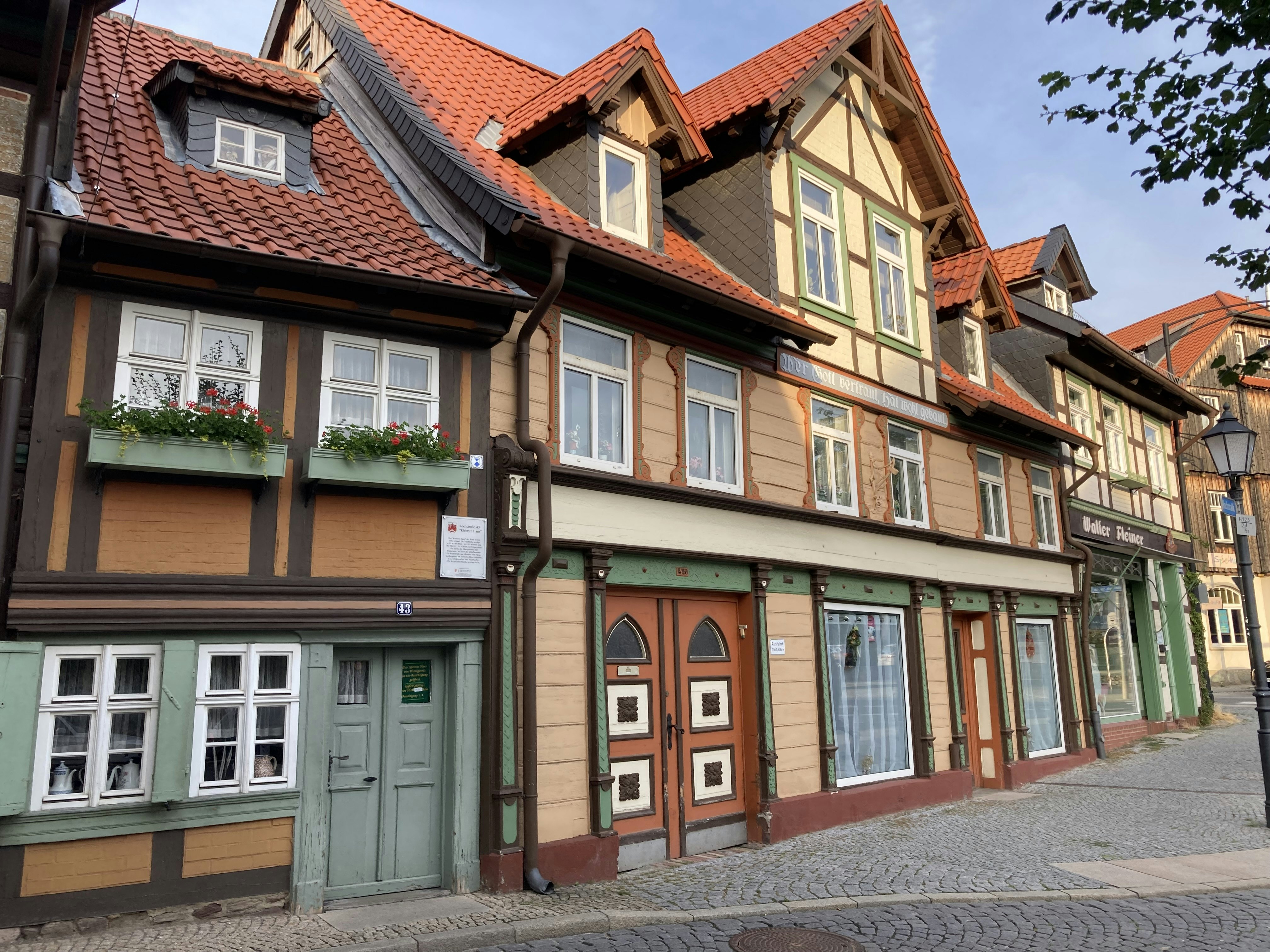How I traveled using Germany’s €9 travel pass: my 48-hour itinerary

Aug 2, 2022 • 7 min read

Alex in front of the old town hall of Wernigerode © Alex Butler / Lonely Planet
With high fuel and flight prices, summer travel is proving much pricier than any of us would have liked.
Perhaps that’s why Germany’s announcement that it would offer country-wide public transport passes for just €9 a month this summer - for locals and visitors alike - made headlines around the world.
I was particularly excited, as I had already been planning to spend July in Berlin. So far, the pass has been an unbeatable deal for exploring the city, but I also wanted to see how it could be used for a weekend adventure. In just over 48 hours, I was able to see half-timber homes, mountain views and art museums - all in parts of Germany I would have never thought to visit otherwise, and all for less than the cost of lunch.
How does the €9 travel pass work?
Passes can be bought online here and are valid for the calendar month. (This deal only runs until August 31, so there’s only one month left to make the most of it.) You’ll receive a digital pass with a QR code - keep it handy on your phone (or print a copy for good measure) as it will be checked fairly regularly.
The pass can be used on all public transport, like buses, trams, S-bahns, U-bahns and regional trains. However, it does not apply to the fast intercity trains like ICE and IC. Because the pass doesn’t apply to the faster long-distance trains, expect journeys to take much longer and to sometimes include multiple transfers.
Traveling to Germany? 6 questions you need to ask before you go
Planning a weekend away using the €9 travel pass
With roughly 48-hours free for a trip, I wanted to pack in as much as possible, without spending the entire weekend on trains. That meant not trying to pack in a cross-country journey and instead focusing on smaller communities that are closer to home. After a bit of research, I settled on a first stop.
(Want to cut straight to Germany's best journeys? Check out our list of the top €9 itineraries).
Top 10 national parks in Germany

The quaint streets of Quedlinburg
The nearly 2-hour journey from Berlin to Quedlinburg required transferring from the S-bahn to two different regional trains. With our first train delayed, my partner and I nearly missed our transfer - a definite hazard of connecting multiple regional trains.
But once we arrived, it was more than worth racing through train stations. Quedlinburg offered a postcard view of Germany I’d yet to see in person. With limited time, we walked the streets to take in some of the more than 1300 half-timber buildings Quedlinburg is famous for. In fact, the entire Old Town is a Unesco World Heritage Site, described as being “an exceptional example of a medieval European town”.
While the streets impressed from below, we headed to the Sternkeikerturm observation tower, where a €1 coin unlocks a revolving gate to climb above for a view. Not content with just one view, we walked up to the Stiftskirche St. Servatii (a church currently mostly under scaffolding) with grounds that look over the town below. Lunch and a walk through the historic neighborhood of Münzenberg was all we had time for before heading to the train station for our next stop.

Off to Wernigerode in the Harz mountains
Making our second stop in the town of Wernigerode was an easy choice. With just one transfer on the half-hour journey, it seemed a simple trip for the pay-off: more beautiful half-timber buildings, amazing views of the Harz mountains and a storybook castle overlooking the town.
Since this would be where we’d spend the night, we dropped off our bags at the hotel and took in the lovely view of the red-roofed buildings nestled amongst the hills, before wandering into the town below to check out the sites (an incredible old town hall, Wernigerode’s smallest house) until the sky turned dark.

I hadn’t yet planned where our adventure would take us the following day. While I’d originally thought we would continue on our small-town journey, I realized that having seen what we had, any more picturesque views were almost guaranteed to have diminishing returns. Instead, we started weighing the options for a city we could visit - without wasting the better part of our sightseeing time on the train. Hanover and Leipzig both seemed feasible, with Leipzig winning out because of its attractions and that it would bring us closer back to Berlin.
With our plan settled, we awoke the following day to do a quick hike up to and tour of the Wernigerode Castle, which began as a medieval fortress and developed into a “romantic residence castle” through the centuries. After that it was down to the train for our next journey.
Wine on the Rhine: three German wine regions off the beaten path

A night in Leipzig
The 2-hour and 2-transfer journey was an easy one - we snagged seats immediately and settled in for a relaxing ride. Since it was already about 4pm when we arrived in Leipzig, we rushed to the Museen im Grassi, and, because we were short on time, opted to focus on the decorative arts museum - particularly to see the Art Deco and Art Nouveau collections.
Leipzig, which is oft-dubbed the new Berlin as it becomes a hot spot for those leaving the German capital, is home to long ‘passageways’ owed to its past as a trading center. We wandered to the Mädlerpassage - a massive five-story covered hall home to bars, restaurants and shops - for a walk past the Auberbachs Keller restaurant, famous as a setting in Goethe’s Faust, and a quick cocktail at the aptly-named Mephisto.
From there we scoped out the sites of the old town to see the incredible architecture. Exhausted after our travels, we then had to head to the hotel to crash before our journey home the next day.
Top 12 things to do when you visit Germany
Back to Berlin
Perhaps unsurprisingly, the trains from Leipzig to Berlin were busy, as we were accompanied by many travelers on their way to the airport. However, our route home required us to switch from regional trains back to the S-bahn - meaning there was time for a quick final detour to Schlachtensee lake, where we had a swim and washed the travel off before heading home.
As a one-way high-speed train from Berlin to Leipzig alone can cost more than €30, I couldn’t believe what value this travel pass provides for exploring Germany - if you’re willing to go slowly.
How to plan a route using the €9 euro travel pass
While you may usually rely on apps like Google Maps for trip-planning, it won’t be of much help here: Google usually suggests the fastest route from point A to B - which often requires taking the exact high-speed trains the pass doesn’t cover. Instead, make your life easy and download the Deutsche Bahn app (or use the website). Go into the options and under “means of transport” select “regional transport only”. That will immediately remove ICE and trains you can’t take with the pass from the options, so you’ll only see routes you can actually take.
These top hikes in Germany show why walking is a way of life here

Are the trains busy?
They can be. I traveled over the weekend, and some were quite packed, with lots of people standing in aisles or sitting on their bags. But on some regional routes, we just hopped on and grabbed seats. Since it can be hard to predict, I’d advise packing light and preparing to stand - and being pleasantly surprised if you happen to snag a seat.
Top 10 reasons to visit Bavaria
The bottom line
If you’re a short-on-time traveler trying to make a quick day trip to another city in Germany, shell out for an ICE ticket. But if you want to have a fun, slightly different journey that will push you to explore places you might not have done otherwise, get the DB app and start mapping a journey. Regardless of how long you’ll be spending in Germany, this pass is an incredible deal that is worth making the most of.






